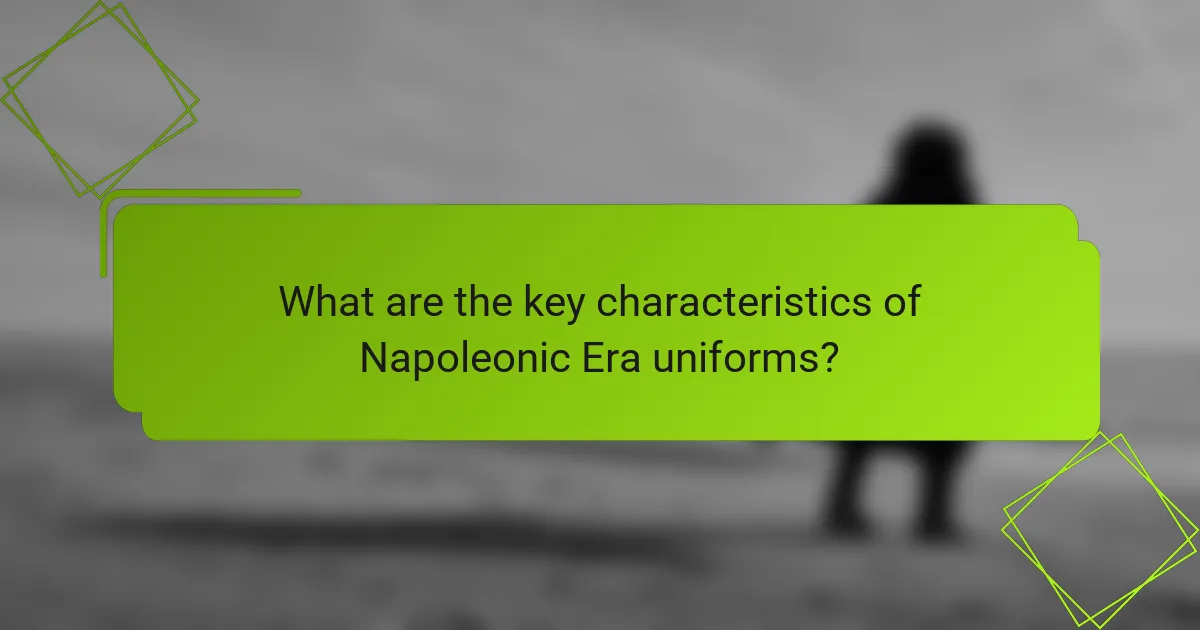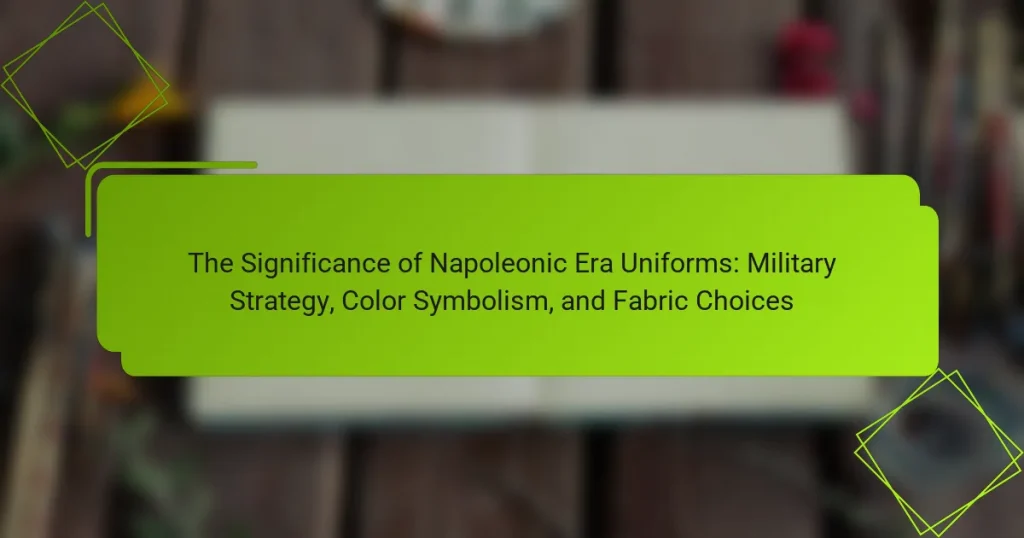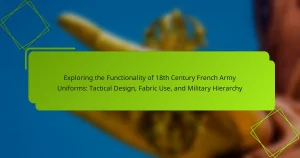Napoleonic Era uniforms serve as a significant entity in military history, characterized by their distinctive colors, elaborate designs, and functional elements. The article examines how these uniforms, featuring bright colors and intricate details like epaulettes and sashes, played a crucial role in conveying military hierarchy and identity during the Napoleonic Wars. It further explores the implications of color symbolism, fabric choices, and their influence on military strategy and contemporary uniform design. Additionally, the study highlights advancements in textile technology and the social and political contexts surrounding these uniforms, enriching our understanding of the era’s military practices and their lasting impact.

What are the key characteristics of Napoleonic Era uniforms?
Napoleonic Era uniforms are characterized by their distinctive colors, elaborate designs, and functional elements. The uniforms often featured bright colors to denote different regiments. Red, blue, and green were common choices, reflecting national pride and military hierarchy. The use of epaulettes and sashes added to the visual impact and rank distinction. Tailcoats were prevalent, designed for ease of movement in battle. Breeches or trousers complemented the coats, often adorned with decorative elements. Additionally, the materials used were chosen for durability and comfort, such as wool and cotton. Overall, these uniforms played a crucial role in military identity and strategy during the Napoleonic Wars.
How did military strategy influence the design of these uniforms?
Military strategy significantly influenced the design of Napoleonic era uniforms. The uniforms were designed for visibility on the battlefield. Bright colors facilitated easy identification of troops during combat. This was crucial for maintaining unit cohesion and command. The cut and structure of the uniforms allowed for mobility and comfort. Tactical maneuvers required soldiers to move swiftly. Specific designs also reflected rank and unit affiliation. Distinctive insignia helped in recognizing leadership and unit types. Historical records indicate that these design choices enhanced operational effectiveness.
What were the primary military objectives that shaped uniform design?
The primary military objectives that shaped uniform design included functionality, visibility, and morale. Functionality ensured that uniforms allowed for ease of movement and protection in combat. Visibility was crucial for identification on the battlefield, promoting unit cohesion and reducing friendly fire. Morale was enhanced through distinctive colors and designs, fostering pride among troops. Historical records indicate that uniforms were often designed to reflect national identity and military tradition, further influencing their appearance. These objectives collectively guided the evolution of military uniforms during the Napoleonic Era.
How did battlefield conditions affect uniform functionality?
Battlefield conditions significantly impacted uniform functionality during the Napoleonic Era. Harsh weather conditions, such as rain and snow, affected the durability and comfort of uniforms. Mud and dirt could render uniforms heavy and less effective for movement. The need for camouflage became apparent as open battlefields required soldiers to blend into their surroundings. Additionally, the weight of uniforms influenced soldier mobility and endurance. Historical accounts indicate that soldiers often suffered from heat exhaustion due to heavy fabric choices. The design of uniforms also needed to accommodate quick access to weapons and gear. Overall, battlefield conditions necessitated adaptations in uniform design to ensure effectiveness and soldier survival.
What role did color symbolism play in Napoleonic uniforms?
Color symbolism played a crucial role in Napoleonic uniforms. It served to convey rank, unit identity, and national pride. Bright colors distinguished different regiments, enhancing visibility on the battlefield. For instance, the French Imperial Guard wore distinctive dark blue and gold, symbolizing loyalty and valor. Red was often associated with artillery, reflecting strength and bravery. Color choices also aimed to intimidate opponents and boost morale among troops. Historical records indicate that these symbolic colors were carefully selected to reflect the values and aspirations of the Napoleonic military.
Which colors were predominantly used and what did they represent?
The predominantly used colors in Napoleonic era uniforms were blue, red, and white. Blue represented loyalty and valor, often associated with the French army. Red symbolized courage and sacrifice, commonly used in artillery and infantry regiments. White indicated purity and was frequently seen in the uniforms of the French guards. These colors were not only aesthetic choices but also served to convey specific meanings and values associated with military service. The use of these colors helped to establish a strong visual identity for the troops. Historical records show that these color choices were standardized to inspire unity and morale among soldiers.
How did color choices impact troop morale and identity?
Color choices significantly impacted troop morale and identity during the Napoleonic Era. Bright colors were used to instill pride and unity among soldiers. For example, the French army’s use of blue uniforms became a symbol of national identity. Troops felt a sense of belonging when dressed in distinctive colors. This visual cohesion enhanced morale, especially during battles. Historical records indicate that soldiers were more motivated when wearing uniforms that represented their regiment. Additionally, colors served tactical purposes, helping to distinguish friend from foe on the battlefield. Overall, color choices played a crucial role in shaping both the psychological and social aspects of military life.
What materials were commonly used in the fabrication of these uniforms?
Wool and cotton were commonly used materials in the fabrication of Napoleonic era uniforms. Wool provided warmth and durability, making it ideal for various weather conditions. Cotton was often used for lighter uniforms and summer wear. Linen was also utilized for its breathability and comfort. These materials allowed for both functionality and style in military attire. Historical records indicate that the choice of fabric was crucial for maintaining soldier morale and performance. The combination of these fabrics contributed to the distinctive appearance of the uniforms during the Napoleonic Wars.
What were the advantages and disadvantages of different fabrics?
Different fabrics used in the Napoleonic Era uniforms had distinct advantages and disadvantages. Wool was durable and provided warmth, making it ideal for colder climates. However, it could be heavy and uncomfortable in warmer weather. Cotton was lighter and breathable, suitable for summer uniforms, but it lacked the durability of wool. Linen was also lightweight and cool, but it wrinkled easily and offered less protection. Silk was luxurious and visually appealing, enhancing the uniform’s prestige, yet it was expensive and less practical for military use. Each fabric choice reflected a balance between functionality and the need for military aesthetics.
How did fabric choices reflect the resources available during the era?
Fabric choices during the Napoleonic Era reflected the available resources through material types and regional production capabilities. Wool was commonly used due to its abundance in Europe, particularly in Britain and France. Cotton became popular as trade routes expanded, making it more accessible. The use of linen was prevalent in warmer climates, reflecting agricultural practices in those regions. Silk was reserved for high-ranking officers, indicating wealth and status. The choice of fabric also illustrated technological advancements in textile production, such as the spinning jenny and power loom. These innovations increased fabric availability and variety, allowing for more elaborate uniforms. Overall, fabric choices were a direct representation of economic conditions and resource distribution during the era.

Why is the study of Napoleonic Era uniforms significant today?
The study of Napoleonic Era uniforms is significant today for understanding military history and strategy. These uniforms reflect the evolution of military tactics and organization. They also illustrate the importance of color symbolism in warfare. For example, specific colors were chosen to convey messages and morale. Additionally, the fabric choices reveal advancements in textile technology of the time. The design of these uniforms influenced modern military attire. Historical analysis of these uniforms provides insights into social and political contexts. This knowledge enriches our comprehension of the Napoleonic Wars and their impact on contemporary military practices.
How do these uniforms inform our understanding of military history?
Napoleonic era uniforms provide insights into military history through their design and symbolism. These uniforms reflect the military strategies employed during the Napoleonic Wars. The colors and styles were often chosen to convey rank and unit affiliation. For instance, the use of bright colors helped in battlefield identification and morale. Additionally, the fabric choices indicate the technological advancements of the time. The uniforms also represent the political and cultural influences of the era. By studying these garments, historians can trace changes in military organization and tactics. Overall, uniforms serve as a visual representation of the evolution of military practices.
What can we learn about the social and political context of the time through uniforms?
Uniforms reflect the social and political context of the Napoleonic Era. They signify the hierarchy and structure within military ranks. The color schemes and designs often represented national pride and loyalty. For example, the use of specific colors was tied to national identity. Uniforms also indicated the relationship between the military and civilian governance. They showcased the power dynamics of the time, especially with the rise of nationalism. Additionally, uniforms were used to instill discipline and unity among troops. Historical records show that uniforms evolved with changing political climates. Overall, uniforms serve as a visual representation of the era’s values and conflicts.
How have these uniforms influenced modern military attire?
Napoleonic era uniforms have significantly influenced modern military attire. Their distinctive styles introduced structured silhouettes and formal designs. Innovations in fabric, such as the use of wool and cotton blends, became standard. The bold colors and intricate insignia set a precedent for modern military regalia. The emphasis on functionality and comfort in these uniforms informed contemporary designs. Military organizations adopted similar color schemes for identification and morale. Additionally, the use of epaulettes and sashes remains prevalent in today’s uniforms. Overall, these historical uniforms laid the groundwork for the aesthetic and practical aspects of modern military clothing.
What insights do we gain about leadership through uniform design?
Uniform design reflects leadership principles by conveying authority and unity. The visual impact of uniforms establishes a sense of order and discipline. Historical examples show that well-designed uniforms can enhance morale among troops. During the Napoleonic Era, uniforms symbolized rank and allegiance. Color choices communicated various messages, such as courage or loyalty. Uniforms also fostered a collective identity within military units. Leaders used uniform design to inspire confidence and obedience. Overall, uniform design serves as a tool for leaders to influence and motivate their teams.
How did leaders utilize uniforms to establish authority and hierarchy?
Leaders utilized uniforms to establish authority and hierarchy by creating distinct visual identities for their ranks. Uniforms signified the status of individuals within military and governmental structures. They often featured specific colors, designs, and insignia that represented different ranks and roles. For example, during the Napoleonic Era, the use of elaborate uniforms helped to reinforce the command structure. Officers wore more ornate attire compared to enlisted soldiers, visually communicating their higher status. This differentiation fostered discipline and unity within the ranks. Historical records indicate that Napoleon’s use of uniforms was deliberate in projecting power and control. The consistent application of uniform styles helped to instill a sense of order and loyalty among troops.
What lessons can contemporary leaders learn from historical uniform strategies?
Contemporary leaders can learn the importance of branding and identity from historical uniform strategies. Uniforms during the Napoleonic Era were designed to create a strong visual identity for military units. This helped to foster unity and morale among troops. The color symbolism in uniforms conveyed messages about loyalty and courage. Leaders can apply these principles to modern organizational branding. A cohesive identity can enhance team spirit and public perception. Historical examples, such as the French army’s distinctive blue uniforms, demonstrate the effectiveness of visual strategy in leadership. By understanding these lessons, contemporary leaders can strengthen their own organizational strategies.

What are the practical implications of studying Napoleonic Era uniforms?
Studying Napoleonic Era uniforms has practical implications for understanding military strategy and historical context. These uniforms reflect the tactics and organization of armies during that time. They also illustrate the role of color symbolism in conveying rank and unit identity. Analyzing fabric choices reveals insights into supply chains and technological advancements in textile production. Furthermore, this study aids in the preservation of military history and informs modern military uniform design. The distinct styles of uniforms can influence contemporary fashion and cultural representations. Overall, the implications extend beyond historical interest to practical applications in various fields.
How can reenactors and historians accurately replicate these uniforms?
Reenactors and historians can accurately replicate Napoleonic era uniforms by using primary sources and historical records. They should study original paintings, military manuals, and surviving garments. These resources provide details about construction techniques and materials used. Authentic fabrics like wool and cotton should be sourced to match historical accuracy. Accurate color dyes must be used to reflect period-specific hues. Tailoring techniques from the era should be employed to ensure proper fit and style. Collaboration with experts in historical costume can enhance accuracy. Documented examples of uniforms from museums can serve as reliable references for replication.
What resources are available for sourcing authentic materials?
Authentic materials for Napoleonic era uniforms can be sourced from specialized historical textile suppliers. These suppliers often provide reproductions of fabrics used during the period. Museums with military collections may also offer insights and access to original materials. Academic institutions sometimes have archives that include textile samples. Online marketplaces focused on historical reenactment can be valuable for finding specific items. Additionally, historical societies dedicated to the Napoleonic era may have resources and contacts for sourcing materials.
What techniques are essential for authentic uniform construction?
Essential techniques for authentic uniform construction include precise tailoring, accurate fabric selection, and historical pattern replication. Tailoring ensures a proper fit, which reflects the military standards of the Napoleonic era. Fabric selection must consider period-appropriate materials, such as wool or linen, to maintain authenticity. Historical patterns should be sourced from original uniforms to ensure accuracy in design. These techniques collectively contribute to the authenticity of Napoleonic uniforms, reflecting their significance in military strategy and symbolism. Historical references confirm that attention to these details was crucial for creating uniforms that represented rank and regiment effectively.
How can the principles of uniform design be applied in modern contexts?
The principles of uniform design can be applied in modern contexts by emphasizing functionality, visual identity, and historical resonance. Modern military and organizational uniforms often prioritize practicality, ensuring ease of movement and comfort. Visual identity is crucial; uniforms create a sense of belonging and professionalism. For instance, color schemes and insignia can evoke historical significance, much like Napoleonic uniforms symbolized rank and unit. Additionally, modern uniforms often incorporate advanced materials for durability and performance, reflecting the evolution from historical fabric choices. The integration of these principles enhances cohesion and effectiveness in contemporary settings.
What best practices can be derived from the color and fabric choices of the Napoleonic Era?
Best practices from the color and fabric choices of the Napoleonic Era include strategic color selection for visibility and morale. Bright colors like blue and red were used to enhance visibility on the battlefield. These colors also fostered a sense of unity and identity among troops. The use of wool and cotton fabrics provided durability and comfort in various weather conditions. Additionally, the layering of fabrics allowed for adaptability in different climates. Historical records indicate that uniforms were designed for both functionality and psychological impact. This approach helped to boost troop confidence and deter enemy morale. Overall, the Napoleonic uniform choices illustrate the importance of color and fabric in military strategy.
How can understanding historical uniforms enhance contemporary military strategy?
Understanding historical uniforms can enhance contemporary military strategy by providing insights into the effectiveness of design and symbolism. Historical uniforms, such as those from the Napoleonic era, were crafted for visibility, morale, and psychological impact. The bright colors and distinct styles served to inspire troops and intimidate opponents. Analyzing these elements helps modern strategists recognize the importance of uniform design in fostering unit cohesion and identity. Moreover, the study of fabric choices reveals practical considerations like durability and climate adaptability. Historical examples illustrate how uniformity can affect battlefield tactics and communication. By learning from past practices, contemporary military forces can refine their own strategies for uniform design and deployment.
The main entity of this article is Napoleonic Era uniforms, which are characterized by their distinctive colors, elaborate designs, and functional elements that reflect military strategy and identity. The article explores the influence of military objectives on uniform design, highlighting the significance of visibility, functionality, and morale. It also examines the role of color symbolism in conveying rank and national pride, as well as the materials used in uniform fabrication, such as wool and cotton. Additionally, the article discusses the historical context of these uniforms and their lasting impact on modern military attire and strategies.




